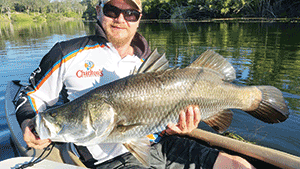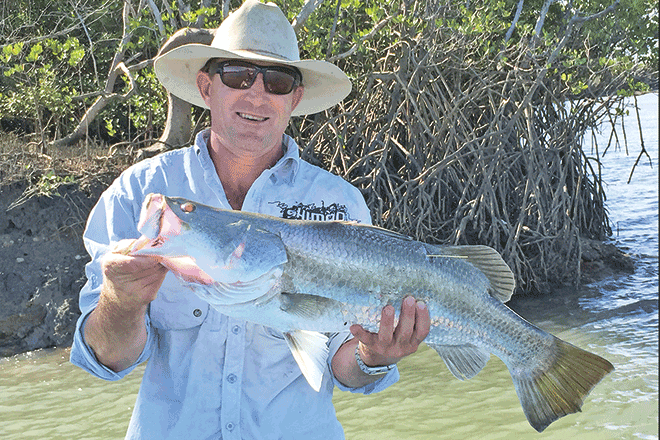IT’S that time of year again when many people start to get barra madness and look for a fix on these awesome fish.
Yep from February 1 the saltwater Queensland barra closed season is finished and you can start to prowl your waterways in pursuit of a chrome beast. Whether you’re a lure or bait fisher, when you see a big barra attached to your line erupt from the water you get a squirt of adrenalin.
Around central Queensland, fishing the deeper water is the most consistent way to catch large barra.

It can be hard to fish these places during the peak run of the tides and most are best fished as the tides get towards the top and bottom.
The joy of fishing deeper water is it can be fished on both tides because you are targeting fish that don’t move as much with the tidal flow. This is where vibration lures have come into their own with their ability to get down deep quickly.
Soft plastics rigged on heavy jig heads work just as well, with a paddle tail or grub of 100-125mm doing the job. Trolling with hard-bodies that dive from 4-8m depending on the water depth will catch you good numbers of barra. Lethal Lures, Classic, Bomber, Killalure and Lucky Craft all make good deep-diving lures that will cover most of the depths you come across.
You need to ensure your lure is getting close to the bottom, if not hitting it every now and again. If you’re trolling an area with a lot of structure such as fallen timber, choose a lure that just runs across the top of the snags and a barra will rise to hit it. Original Prawnstars are a good option if the area you are fishing has loads of structure because they are relatively snag resistant.
Large live baits such as mullet, pike and whiting are some of the best around. Don’t be afraid to use a bait that looks too big because a large barra will easily inhale a 25-30cm mullet. Barra will be found in areas with no visible structure on the sounder but where food is readily available.
This includes places such as the junction of creeks or a feeder creek and a main channel. Bridge pylons in the Fitzroy, Calliope and Boyne rivers hold good numbers of barra that sit behind the pylons waiting for a feed. They also hold in these locations to get out of the current because the pylons create an eddy behind them for the fish to rest in.
Rocky drop-offs in Gladstone Harbour, a lot of the Boyne River and Devils Elbow in the Calliope River are other excellent barra hiding spots. The Fitzroy River has a number of river edges that drop off quickly into deep water and fish will move around on these edges during the tides.
Fishing around the town reach of the Fitzroy will give up fish from 20cm to well over the magic metre mark. This has to be the most-fished area in the Fitzroy but it still produces plenty of fish. On any weekend you will see a large number of boats trolling back and forwards but many of them have success.
Although I haven’t fished much of Port Alma, it covers a vast area and people who have put in the effort get good results. Plenty of barra were being caught around the region before the closure. I have only captured a couple of smaller fish since then while targeting other species.
Pikes Crossing will still produce a few fish for anyone who wants to drop in a kayak and flick along the edges. The odd school of tarpon will also be up there and it might be worth taking a lighter rod as well if you have the room. During the closure, I tended to move into shallower parts of the river targeting jacks around rock bars and fallen trees.
Jacks have been in fairly good numbers, hitting lures at will, though a fresh cut bait will really get their attention. I only wish the average size would creep up to match what’s caught down south. But hey, any jack is a good jack.
Pikey bream are harassing the small prawns that are thick at the moment and they are willingly taking small soft plastics and hard-body lures. Prawn baits will catch a heap of these fish but you will get lots of small fish because the bigger ones will be more interested in a live herring or small mullet.
Flathead are being caught around the Lillies and Wild Cattle Creek, with 100mm soft plastics and 65-90mm hard-bodies doing the damage. The Fitzroy and Port Alma are giving up good numbers of threadfin salmon, with vibes the preferred lure for these fish. If you get onto a school it’s not uncommon to get a few fish quickly until they move on.
Mud crabs were thick during December and early January. A lot were empty but they will fill over the coming months. There really is not any use taking empty crabs because they are full of water when you open them, meaning you don’t get a great deal of meat.
Hopefully you can get a few barra early in the season.
Cheers and happy fishing from Gladdy.
For more autumn fishing tips for Central Queensland, click here!
 Bush 'n Beach Fishing Magazine Location reports & tips for fishing, boating, camping, kayaking, 4WDing in Queensland and Northern NSW
Bush 'n Beach Fishing Magazine Location reports & tips for fishing, boating, camping, kayaking, 4WDing in Queensland and Northern NSW








